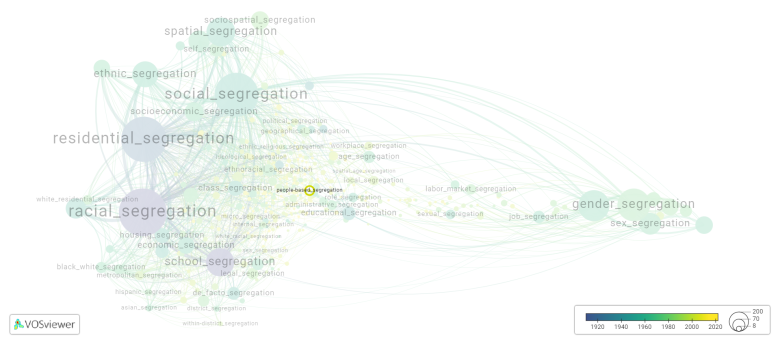People-based segregation: Difference between revisions
(Creating page) |
(Creating page) |
||
| Line 26: | Line 26: | ||
[[File:people-based_segregation.png|780x780px]] | [[File:people-based_segregation.png|780x780px]] | ||
Visualization based on the [[How_to_cite_Segregation_Wiki| research]] | |||
For the complete network of associated segregation forms, see: | For the complete network of associated segregation forms, see: | ||
year of publication https://tinyurl.com/2235lkhw | * First year of publication https://tinyurl.com/2235lkhw | ||
Louvain clusters https://tinyurl.com/2d8wg5n3 | * Louvain clusters https://tinyurl.com/2d8wg5n3 | ||
* Betweenness centrality https://tinyurl.com/223udk5r | |||
* Disciplines where segregation forms first appeared https://tinyurl.com/244d8unz | |||
==References== | ==References== | ||
==Notes== | ==Notes== | ||
Revision as of 13:41, 3 October 2024
Date and country of first publication[1]
2015
Estonia
Definition
People-based segregation refers to the separation or division of people based on factors such as race, ethnicity, religion, socioeconomic status, or other personal characteristics. It is a practice that creates social and physical barriers between different groups of people, leading to inequality, discrimination, and limited opportunities for certain individuals or communities.
Historically, people-based segregation has been enforced through various means, such as legal policies, social norms, and economic practices. These measures have resulted in segregated neighborhoods, schools, workplaces, and public spaces, where individuals from different backgrounds are isolated from one another.
The consequences of people-based segregation are significant. It perpetuates inequality, as certain groups face limited access to resources, education, healthcare, and job opportunities. Moreover, it can contribute to social tensions, prejudice, and stereotypes, leading to a fragmented society.
Efforts to combat people-based segregation have taken various forms, including civil rights movements, legislation, affirmative action policies, and community-based initiatives. The goal is to promote inclusivity, diversity, and equal opportunities for all individuals, regardless of their personal characteristics.
It is important to recognize and address people-based segregation in order to build a more inclusive and equitable society. This requires addressing systemic barriers, promoting social integration, and fostering understanding and acceptance among different communities.
Synonyms
The following terms are synonymous with:
people based segregation.
References and literature addressing this segregation form under these synonymous terms can be found below.
See also
Related segregation forms
People-based segregation is frequently discussed in the literature with the following segregation forms:
Visualization based on the research
For the complete network of associated segregation forms, see:
- First year of publication https://tinyurl.com/2235lkhw
- Louvain clusters https://tinyurl.com/2d8wg5n3
- Betweenness centrality https://tinyurl.com/223udk5r
- Disciplines where segregation forms first appeared https://tinyurl.com/244d8unz
References
Notes
- ↑ Date and country of first publication as informed by the Scopus database (December 2023).
At its current state, this definition has been generated by a Large Language Model (LLM) so far without review by an independent researcher or a member of the curating team of segregation experts that keep the Segregation Wiki online. While we strive for accuracy, we cannot guarantee its reliability, completeness and timeliness. Please use this content with caution and verify information as needed. Also, feel free to improve on the definition as you see fit, including the use of references and other informational resources. We value your input in enhancing the quality and accuracy of the definitions of segregation forms collectively offered in the Segregation Wiki ©.
People-based segregation appears in the following literature
Järv O., Müürisepp K., Ahas R., Derudder B., Witlox F. (2015). Ethnic differences in activity spaces as a characteristic of segregation: A study based on mobile phone usage in Tallinn, Estonia. Urban Studies, 52(14), 2680-2698. SAGE Publications Ltd.https://doi.org/10.1177/0042098014550459

